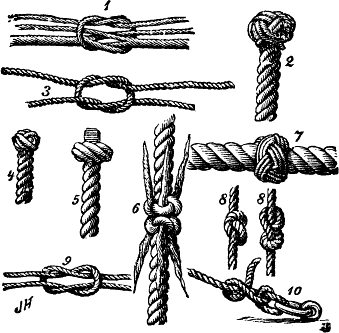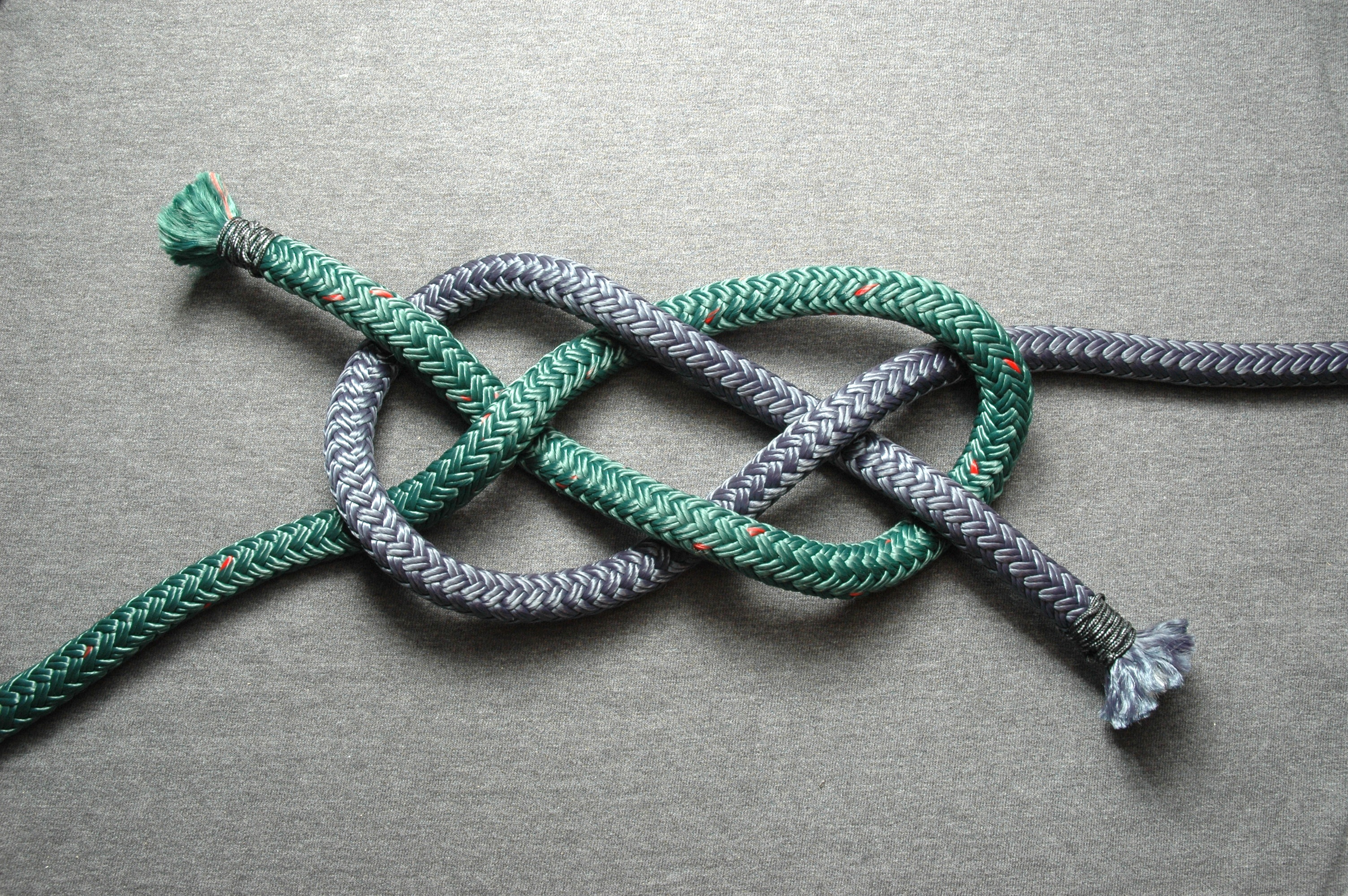|
Sailor's Hitch
The sailor's hitch is a secure, jam-proof hitch knot. A hitch knot is a type of knot that has the ability to fit to the size and shape of an object that it is being tied to. The sailor's hitch is similar in function and appearance to the swing hitch. The sailor's hitch can be used in such a way that allows a smaller rope to be attached to a large rope. The smaller rope should be pulled to the left while the bight should go through the final tuck to form the final product of a sailor's hitch. This knot can also serve the purpose of a cleat hitch. There is another variation of the knot with several more turns that is called the gripping sailor's hitch. The gripping sailor's hitch is commonly confused with the icicle hitch, but it has distinctions with the last tuck of the knot that allows them to be different. The sailor's knot is used in the following circumstances: *search and rescue *mountaineering *climbing *boating *horse and livestock *camping *scouting See also * ... [...More Info...] [...Related Items...] OR: [Wikipedia] [Google] [Baidu] |
Knot
A knot is an intentional complication in Rope, cordage which may be practical or decorative, or both. Practical knots are classified by function, including List of hitch knots, hitches, List of bend knots, bends, List of loop knots, loop knots, and Rope splicing, splices: a ''hitch'' fastens a rope to another object; a ''bend'' fastens two ends of a rope to each another; a ''loop knot'' is any knot creating a loop; and ''splice'' denotes any multi-strand knot, including bends and loops. A knot may also refer, in the strictest sense, to a stopper (knot), stopper or knob at the end of a rope to keep that end from slipping through a grommet or eye. Knots have excited interest since ancient times for their practical uses, as well as their Topology, topological intricacy, studied in the area of mathematics known as knot theory. History Knots and knotting have been used and studied throughout history. For example, Chinese knotting is a decorative handicraft art that began as ... [...More Info...] [...Related Items...] OR: [Wikipedia] [Google] [Baidu] |
Hitch Knot
A hitch is a type of knot used to secure a rope to an object or another rope. Hitches are used in a variety of situations, including climbing, sailing, and Load securing, securing loads. They are classified based on their ability to be tightened or Knot#Releasability, released, their resistance to Slipping (knot), slipping, and their Knot strength, strength. Some common types of hitch knots include the clove hitch, the timber hitch, and the round turn and two half-hitches. Physical theory A simple mathematical theory of hitches has been proposed by Bayman. It predicts whether or not a hitch will hold, given the diameter of the post, the diameter of the rope, and the coefficient of friction between the post and the rope. The theory has been extended by Maddocks and Keller, including an approximate treatment of knots that are not hitches. For example, they predict that a square knot will hold when the coefficient of friction of the rope with itself is greater than 0.24. These predi ... [...More Info...] [...Related Items...] OR: [Wikipedia] [Google] [Baidu] |
Swing Hitch
Swing hitch is a way to tie a swing rope to a branch or other horizontal beam. Ashley describes it in ABOK as "... firm, strong, secure, and easily untied once the load has been removed." This knot serves a similar function to the sailor's hitch. Tying #A clove hitch is tied around the beam with the rope end. #The end continues around the beam until it meets the main part. #The end goes around the main part and then gets stuck under the first turn of the main part; preferably under the point where main part and the bridge of the clove hitch cross each other. #*The end may be slipped for easier dismount or #*The end may be tied to a stopper knot for more security against loosening under use. If the place of attachment is very slippery, near the end of the beam, tapered with less diameter in the pulling direction, then one may start with more than one turn nearest the main part, effectively tying a Gripping sailor's hitch. If the swing is to have two parallel ropes, the standing ... [...More Info...] [...Related Items...] OR: [Wikipedia] [Google] [Baidu] |
Bight (knot)
In knot tying, a bight is a curved section or slack part between the two ends of a rope, string, or yarn.. "Any slack part of a rope between the two ends, particularly when curved or looped." A knot that can be tied using only the bight of a rope, without access to the ends, is described as in the bight. The term "bight" is also used in a more specific way when describing Turk's head knots, indicating how many repetitions of braiding are made in the circuit of a given knot. Bight vs. open loop Sources differ on whether an open loop or U-shaped curve in a rope qualifies as a bight. treats bights and loops as distinct, stating that a curve "no narrower than a semicircle" is a bight, while an open loop is a curve "narrower than a bight but with separated ends". However, ''The Illustrated Encyclopedia of Knots'' (2002) states: "Any section of line that is bent into a U-shape is a bight." Slipped knot In order to make a slipped knot (also slipped loop and quick release knot ... [...More Info...] [...Related Items...] OR: [Wikipedia] [Google] [Baidu] |
Cleat Hitch
The cleat hitch is a knot for securely attaching a rope to a cleat. Tying The hitch begins with a dead turn around the cleat then continues forming an “8”. The hitch is finished with an inverted half hitch. File:Cleat 01 fr.jpg, A dead turn File:Cleat 02.jpg, We cross by making an ''eight'' File:Cleat 03.jpg, Prepare the reverse half hitch File:Cleat 04.jpg, The finished knot See also * List of knots * Cleat * Clove hitch Notes Bibliography * Ashley, Clifford W. (1993) 944 Year 944 ( CMXLIV) was a leap year starting on Monday of the Julian calendar. Events By place Byzantine Empire * Arab–Byzantine War: Byzantine forces are defeated by Sayf al-Dawla. He captures the city of Aleppo, and extends his c ... The Ashley Book of Knots, New York: Doubleday, p. Dust jacket, p.286 * Compton, Nic (2013), The Knot Bible, The complete guide to knots and their uses, London: Adlard Coles Nautical, p.66 * Soles, Clyde (2011), Backpacker magazine’s outdoor kno ... [...More Info...] [...Related Items...] OR: [Wikipedia] [Google] [Baidu] |
Gripping Sailor's Hitch
The gripping sailor's hitch is a secure, jam-proof List of friction hitch knots, friction hitch used to tie one rope to another, or a rope to a pole, boom, spar, etc., when the pull is lengthwise along the object. It will even grip a tapered object, such as a marlin spike, in the direction of taper, similar to the Icicle hitch, and it is much superior to the rolling hitch for that purpose. Tying Image:bobmcgrsailorgrip1.jpg, Make 5 turns around the object at opposite side of to the pull direction of the standing part, then cross the standing part to the pull direction and make one more turn Image:bobmcgrsailorgrip2.jpg, Cross back over the standing part in front, as you change the turn direction to opposite the wraps, come through from the back, and pass under the standing part (following the pen in pic). Image:bobmcgrsailorgrip3.jpg, Tighten up before loading... Image:bobmcgrsailorgrip4.jpg, When pulled to the side opposite the 5 turns, this hitch will hold... See also *L ... [...More Info...] [...Related Items...] OR: [Wikipedia] [Google] [Baidu] |
Icicle Hitch
An icicle is a spike of ice formed when water falling from an object freezes. Formation and dynamics Icicles can form during bright, sunny, but subfreezing weather, when ice or snow melted by sunlight or some other heat source (such as a poorly insulated building), refreezes as it drips off under exposed conditions. Over time continued water runoff will cause the icicle to grow. Another set of conditions is during ice storms, when rain falling in air slightly below freezing slowly accumulates as numerous small icicles hanging from twigs, leaves, wires, etc. Thirdly, icicles can form wherever water seeps out of or drips off vertical surfaces such as road cuts or cliffs. Under some conditions these can slowly form the "frozen waterfalls" favored by ice climbers. Icicles form on surfaces which might have a smooth and straight, or irregular shape, which in turn influences the shape of an icicle. Another influence is melting water, which might flow toward the icicle in a strai ... [...More Info...] [...Related Items...] OR: [Wikipedia] [Google] [Baidu] |
List Of Knots
This list of knots includes many alternative names for common knots and lashings. Knot names have evolved over time, and there are many conflicting or confusing naming issues. The overhand knot, for example, is also known as the thumb knot. The figure-eight knot is also known as the Savoy knot or the Flemish knot. A * Aberdeen knot - preferred for closure of intradermal sutures * Adjustable bend – can be easily lengthened or shortened * Adjustable grip hitch – a simple hitch which may easily be shifted up and down the rope while slack * Albright special – used to tie two different diameters of line together, for instance to tie monofilament to braid *Alpine butterfly (also known as a butterfly loop) – a static loop mostly used by mountain climbers and rappellers for securing a carabiner to static rope * Alternate ring hitching – covering a ring in hitching can prevent damage * Anchor bend – attaching a rope to a ring or similar termination * Angler's loop – ... [...More Info...] [...Related Items...] OR: [Wikipedia] [Google] [Baidu] |
Sailor's Knot
The Carrick bend, also known as the Sailor's breastplate, is a knot used for joining two lines. It is particularly appropriate for very heavy rope or cable that is too large and stiff to be easily formed into other common bends.Geoffrey Budworth, ''The Complete Book of Knots'' (London: Octopus, 1997), 43.Brion Toss, ''Chapman's Nautical Guides: Knots'' (New York: Hearst Marine Books, 1990), 79–80. It will not jam even after carrying a significant load or being soaked with water.Clifford W. Ashley, ''The Ashley Book of Knots'' (New York: Doubleday, 1944), 262–263. As with many other members of the basket weave knot family, the carrick bend's aesthetically pleasing interwoven and symmetrical shape has also made it popular for decorative purposes. Heraldry The Carrick bend is known as the "Wake knot" or "Ormonde knot" when it is used as a heraldic badge.Arthur Charles Fox-Davies, ''A Complete Guide to Heraldry'' (1909), wikisource:A Complete Guide to Heraldry/Chapter 29, p.&nbs ... [...More Info...] [...Related Items...] OR: [Wikipedia] [Google] [Baidu] |
Gripping Sailor's Hitch
The gripping sailor's hitch is a secure, jam-proof List of friction hitch knots, friction hitch used to tie one rope to another, or a rope to a pole, boom, spar, etc., when the pull is lengthwise along the object. It will even grip a tapered object, such as a marlin spike, in the direction of taper, similar to the Icicle hitch, and it is much superior to the rolling hitch for that purpose. Tying Image:bobmcgrsailorgrip1.jpg, Make 5 turns around the object at opposite side of to the pull direction of the standing part, then cross the standing part to the pull direction and make one more turn Image:bobmcgrsailorgrip2.jpg, Cross back over the standing part in front, as you change the turn direction to opposite the wraps, come through from the back, and pass under the standing part (following the pen in pic). Image:bobmcgrsailorgrip3.jpg, Tighten up before loading... Image:bobmcgrsailorgrip4.jpg, When pulled to the side opposite the 5 turns, this hitch will hold... See also *L ... [...More Info...] [...Related Items...] OR: [Wikipedia] [Google] [Baidu] |




